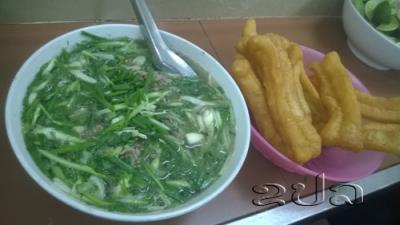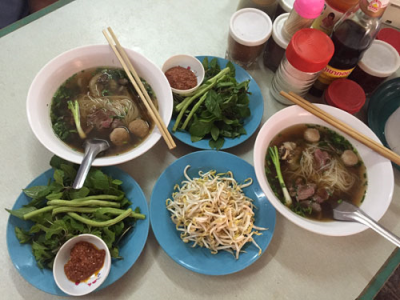KPL
Pho, pronounced as feu, is one of the most common foods among Lao and Vietnamese people. Although it originates from Vietnam, pho in Laos comes in different styles and in the business context, pho is a money making business, mostly family run, for many people.
Manythone and I and our new Vietnamese friend Chu Thuy Linh went out to eat pho at the Thin Noodle Restaurant for lunch. The restaurant is located on Lo Duc Street in Hanoi, which is well known for noodle soup restaurants.

Hanoi pho
By Soukthavy and Manythone
(KPL) Pho, pronounced as feu, is one of the most common foods among Lao and Vietnamese people. Although it originates from Vietnam, pho in Laos comes in different styles and in the business context, pho is a money making business, mostly family run, for many people.
Manythone and I and our new Vietnamese friend Chu Thuy Linh went out to eat pho at the Thin Noodle Restaurant for lunch. The restaurant is located on Lo Duc Street in Hanoi, which is well known for noodle soup restaurants.
After a ten-minute walk from the Vietnam News Agency we arrived at the restaurant. It was our first time eating Hanoi-style pho.
Hanoi pho is served in a bowl with soft flat noodles made from rice with thin cuts of beef and sprinkled with green onions. Sliced chilies, fish sauce, lemon and cayenne pepper are must haves for pho eaters in Hanoi. Deep-fried sticks of dough are also often eaten with pho.
Back in Vientiane, cooks and restaurant owners tend to serve pho with smaller noodles, and most often half-cooked beef, pork, chicken, duck or turkey. The two latter are rarely served.
Cooks tend to sell pho with more vegetables, though the Lao eaters don’t eat dough sticks with pho like the Vietnamese. A bowl of pho is mostly served with chilies (sometimes sliced, ground or fried), long beans, shrimp paste, a wedge of lime or lemon, Asian basil, mint, cilantro, lettuce, and bean sprouts.
Eaters may be disappointed if they are served pho without vegetables, although this is acceptable to Vietnamese eaters. Lao people usually dip cut raw long beans or raw chilies into shrimp paste to eat while enjoying pho.

Vientiane pho
Sugar, fish sauce, chili sauce, and hoisin sauce are also typically provided as condiments on the table.
“It tastes almost the same as the pho we usually eat in Vientiane, but apparently they don’t have vegetables as we do in Vientiane,” Manythone said after she finished her Vietnamese bowl.
“I usually eat pho in the mornings and sometimes at lunch or dinner and I prefer pho with chicken,” said Linh.
Linh said there are two main kinds of pho: beef pho (phở bò) and chicken pho (phở gà). As for pho bo, there are three varieties: pho with boiled beef, pho with stir-fried beef and pho with raw beef. Pho with boiled beef or with raw beef seem to be the most popular in Vietnam.
“The most preferable meat used with pho is beef and I think that most Vietnamese also like beef pho,” she added.
In Hanoi, a bowl of pho costs between 21,000 VND (approx. US$1.00) and 50,000 VND (approx. 18,500 kip). Meanwhile, in Vientiane, pho is usually available from 12,000 kip (US$1.50) up to 25,000 kip (over US$3.00). At one time, it was sold for up to 140,000 kip (almost US$18.00), but the shop selling pho at that price closed a couple of months ago.
Vietnamese pho, a simple soup made of beef broth, herbs, spices and rice noodles, emerged some 100 years ago in Northern Vietnam and has since acquired a global following, loved by French celebrity chefs and cash-strapped American students alike. It is the specialty of a number of restaurant chains around the world.
Pho is a Vietnamese staple. While traditionally a breakfast food, it is now served at all times of the day and eaten regularly by rich and poor alike, usually at the same establishments.
In Southern Vietnam, pho is eaten as breakfast and occasionally for lunch, whereas the Northern Vietnamese eat it at any time of the day.
In Vietnam, Hanoi pho is the most well known. In addition, there is Nam Dinh pho (a province in North Vietnam) and a Southern Vietnamese variety. Customers will find few differences between them.
In the South, people eat vegetables with pho, but not in the North. Hanoians like eating pho in small and narrow pho restaurants, even on the pavement with bowls of pho placed on small chairs. They seem not to care if the spots are nice or not, but more important is that the pho in these restaurants is delicious.
KPL